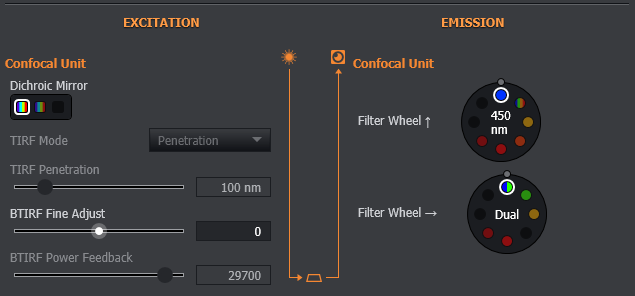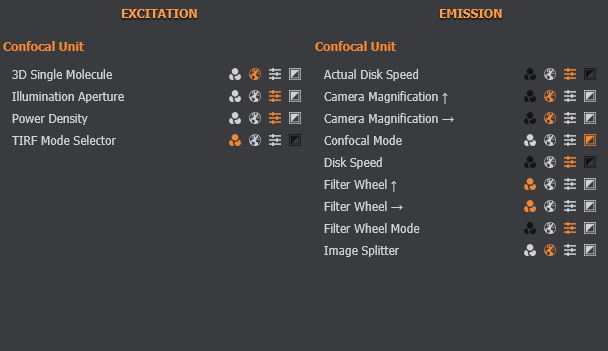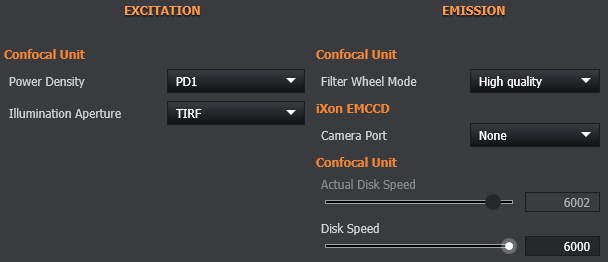Dragonfly Features
Andor's Dragonfly is a multi-modal imaging system.
Depending on the model, it provides the following features:
Confocal (depending on model, choice of 40µm or 25µm pinholes)
Widefield
Multi-colour TIRF (two colours simultaneously)
Borealis TIRF (optimised for x60/x63 or x100 objectives)
Super Resolution Imaging including DNA-PAINT and SRRF-Stream+
Dual-camera simultaneous imaging, with up to four emission-splitting positions
Up to three camera magnification / zoom optics
Up to four illumination zoom / power density optics
3D / astigmatic lens (for 3D super-resolution imaging)
This section will describe controlling these features in Fusion.
The features and locations described below may differ depending on how Fusion is set up on your system. Please see the Imaging Mode and Feature Locations for a description of how features can be moved between Channel, Global, Image Mode and Advanced.
Channel Settings

TIRF Mode - This setting will select between three TIRF Modes.
Penetration - this is the typical TIRF mode, allowing the penetration depth to be defined.
Critical Angle - this is an advanced mode, allowing the critical angle to be adjusted. This setting will affect the results of both the Penetration and HILO modes.
HILO- this is Highly Inclined Laminated Optical sheet mode. It can be considered a high contrast widefield technique, allowing deeper penetration than TIRF, but with higher contrast than widefield.
BTIRF Fine Adjust - This setting adjusts the angle of incident light within the objective for BTIRF. A value of 0 shall be calibrated to be close to the critical angle. The selected value shall determine the current penetration depth / contrast.
BTIRF Power Feedback - This read-only value captures the degree of light reflected within the objective to provide an indication of the current incident angle in relation to the critical angle.
Filter Wheels - The emission filter selected for the secondary (vertical port on 300/500 series, right camera port on 200 series, if applicable) and primary (horizontal port on 300/500 series, left camera port on 200 series).
Global Settings

3D Single Molecule - If fitted (500 series option only), this allows the use of the 3D / astigmatic lens to add astigmatism to the image. This is only available in widefield mode and would typically be combined with the illumination power density (see further down in this section) for dSTORM imaging. The astigmatic lens provides approximately 1 µm of Z depth to be encoded in the image by way of astigmatism, which software analysis can use to provide 3D positional data from a 2D image.
Camera Magnification - If fitted (motorised 3-postion on 300/500 series, optional 2-position on 200 series), the camera magnification for each camera can be selected. Fusion will automatically adjust the pixel size as appropriate. Higher magnification provides higher XY resolution at the cost of image intensity (because the photons are being spread over a larger area on the camera sensor). This is especially useful when using Deconvolution.
Image Splitter - If fitted (all dual-camera models), up to four positions can be selected, switching either the entire image from one camera to another, or splitting different wavelengths to one camera. Usually the longer wavelength will pass to the primary camera. This should be combined with use of the filter wheel (see above section) to ensure that suitable wavelengths can reach the camera(s).
Image Mode

Confocal Mode - Depending on the model being used, up to four options can be selected:
High Contrast (40 µm pinholes)
High Sectioning (25 µm pinholes)
Widefield
TIRF
BTIRF60 (Borealis TIRF 60)
BTIRF100 (Borealis TIRF 100)
Note - because Dragonfly uses a different illumination input pathway for the TIRF mode(s), you should ensure that the ILE output is set correctly. See the ILE Features for details of this.
Feature Locations

All of the various features associated with Dragonfly can be moved between Channel, Global, Advanced and Image Mode. See the Imaging Mode and Feature Locations section for more details.
Advanced Settings

Power Density - If available (300/500 series), this provides the option to increase the illumination power reaching the specimen. Up to four powers are available:
PD1 - Maximum area of illumination with standard power. Used for most widefield and confocal imaging.
PD2 - Medium area of illumination with higher power (4x PD1). Used for challenging samples where more illumination power is needed in widefield or confocal imaging.
PD3 (widefield mode only) - Small area of illumination with very high power (16x PD1). Used for very challenging samples and potentially dSTORM imaging in widefield mode.
PD4 (widefield mode only) - Minimum area of illumination and highest illumination power (36x PD1). Used for dSTORM imaging to enable fluorescence blinking in widefield mode.
Illumination Aperture - A variety of different sizes of illumination aperture. Used to limit the area of illumination reaching the specimen. Most commonly used in conjunction with AOIs (Areas of Interest) on the camera. See iXon EMCCD Camera Settings and Zyla and ZL41 Cell sCMOS Camera Settings.
Filter Wheel Mode - This feature can enable higher speed of emission filter wheel switching. High speed can be used to increase the speed of switching between filter positions. High quality is recommended for most users.
Camera Port - This is a camera feature, but is mentioned here because Fusion needs to know which physical Dragonfly port the camera is connected to. Each camera will have its own setting.
Disk Speed - The actual and desired disk speed is shown here. It is recommended to leave this at maximum speed (6000 rpm). The Sync Camera feature (See iXon EMCCD Camera Settings and Zyla and ZL41 Cell sCMOS Camera Settings.) will use this to determine the correct exposure time.